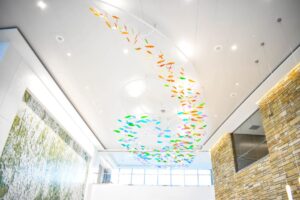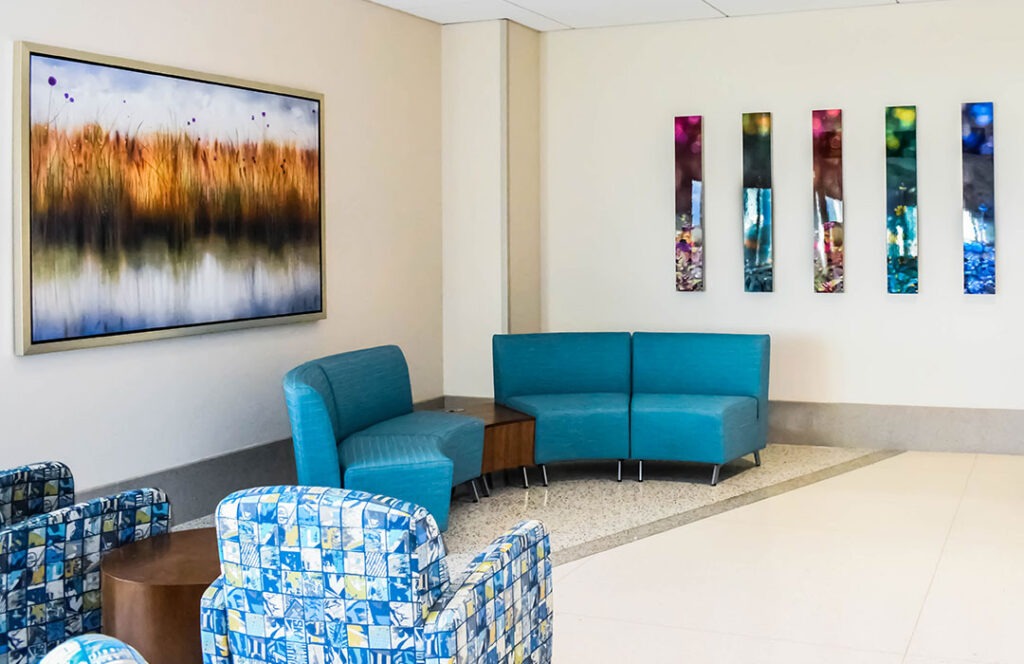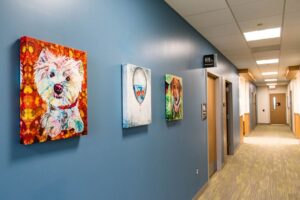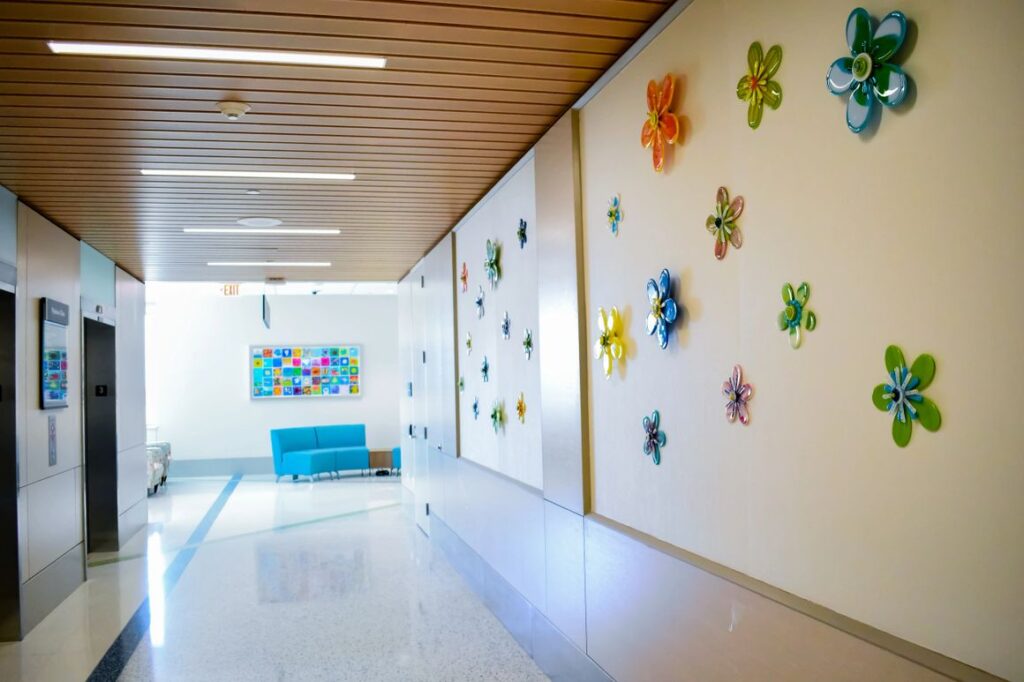Art in Healthcare
You assess need and find that, indeed, there is one. You review and analyze financials, and consult with colleagues, subject matter experts, and close advisors. You take time to examine options, to compare and contrast pros and cons. And after such thoughtful consideration, after you’ve determined that all evidence points to a choice that is proven to be reliable—one that has a strong and measurable impact—you act.
You purchase the Burberry suit. It just hangs better. The material by itself is a wondrous experience. The mirror is your best friend. You feel really good in it. Of course, now you require accessories: shoes, a belt, a shirt or blouse, a tie or scarf, perhaps a pair of socks or some hosiery. You breeze into Wal-Mart, purchase them on clearance, in and out in 15 minutes.
What is wrong with this picture? And, what does it have to do with art in healthcare? As beautifully designed healthcare facilities are built new or expanded, art is generally lumped in with furniture, fixtures, and equipment. This is the end of the building cycle. Because of this, art is frequently given little forethought and is consequently reduced to a package of ubiquitous budget prints that conform to guiding principles that are, in practice, more form than substance.
Art is arguably the first thing people react to when they approach or enter a facility.
When the process for selecting and integrating art with healthcare design fully considers context, art adds value well beyond a visually aesthetic appeal.

Leaving the consideration of art until after the design is complete and construction is nearing final touches is much like buying a fine suit and adorning it with cheap accessories. The potential impact of the accessories is lost, and the quality of the fine suit is diminished.
Today, healthcare design is increasingly guided by evidence-based design. The goal is to inform a comprehensive design approach to create a healing environment. Patterns of movement, exposure to natural light, inside-out views of natural settings, accommodations for patients and their families, colors, textures, technology, electronic media, art, and more, all play a role.
In this environment, elements of design each earn their way and contribute to a sense of place that fosters confidence, comfort, and healing, and, as such, become important allies to healthcare providers.

There is also a clear trend toward hospitality-influenced design in healthcare. The sterile, institutional atmosphere of previous generations of medical facilities is now understood to be counterproductive in many ways. Twenty-first-century consumers of medical services know and expect more. The evidence-based design addresses the full human experience, the psychological, intellectual, and physical response to a space and to the activities that occur in the space.
The benefit of art in healthcare is in the experience of the art. While it may be dismissed by some as mere decoration, decades of research in Europe and the United States conclude otherwise. The role art plays in an overall strategy to produce healing environments has been measured against health and economic outcomes. They include:
- Clinical outcomes, such as length of hospital stay, intake of pain medication, or biological markers like blood pressure and heart rate;
- Patient-, family-, and employee-based outcomes, such as patients’ rate levels of perceived pain, satisfaction with healthcare services or working conditions, etc.; and
- Economic outcomes related to the cost of patient care, cost of employee turnover, etc.
Art is a positive distraction, directly or indirectly, in a variety of situations. It has been shown in a growing body of research to measurably reduce:
- Patient and employee anxiety and stress;
- Pain perception as measured by physiological outcomes, such as blood pressure, heart rate, and skin conductivity response, in addition to self-report measures like pain-rating scales and surveys;
- The need for analgesic medication;
- Depression associated with chemotherapy, dialysis, and other invasive treatments;
- Non-operative treatment times;
- Operative recovery times;
- Mental healthcare treatment times;
- Abusive behaviors by mental healthcare patients;
- Length of hospital stay; and
- Employee turnover, missed days;
It also measurably increases:
- Patient and employee satisfaction;
- Patient, visitor, and employee perception of quality of care; and
- Brand recognition.
 Another measure of the effectiveness of a particular selection of art is its ability to maintain interest; it is an art that doesn’t run out, doesn’t become invisible and irrelevant. Art, when appropriately selected and placed, has durability. It engages the viewers, transports them, delights and amuses them, calms and reassures them, day after day.
Another measure of the effectiveness of a particular selection of art is its ability to maintain interest; it is an art that doesn’t run out, doesn’t become invisible and irrelevant. Art, when appropriately selected and placed, has durability. It engages the viewers, transports them, delights and amuses them, calms and reassures them, day after day.
So, what does it mean to “appropriately select and place art?” The context must drive the design conversation.
Healthcare facilities can be specialized or can house a variety of treatment centers. Though there may be similarities, art that is appropriate for pediatrics will not necessarily be appropriate for oncology. Art for assisted-living centers may differ dramatically from memory care centers. And, with a focus on impression management and wayfinding, the process for selecting and placing art in lobbies, waiting rooms, and the labyrinth of hallways, also varies.
Demographics and local traditions, too, influence selections; for instance, which ethnic groups reside in the communities a facility serves and how is local culture expressed?
The value of art as a positive contributor to employee and customer satisfaction, wayfinding, and, most importantly, healthcare outcomes, varies directly with the integrity of the process used to select and place it.
Art is most effective when approached contextually with a thorough understanding of community, organizational culture, and operations, and through a collaborative design process with building, interior, and landscape architecture.
Finally, art that makes a difference does require an investment. A rule of thumb for budgeting turn-key art services is 1-2% of the construction budget; a small percentage of cost when measured against overall contribution.
Budgets in this range allow for art plans that align and integrate with organizational mission and the intentions of structural and operational design. A thoughtful art program, one with the intention to create a preferred experience, can raise the bar from beautiful, efficient, and effective to extraordinarily beautiful, efficient, and effective.
By Michael Lehman December 1, 2011
https://www.healthcaredesignmagazine.com/trends/architecture/art-healthcare/

